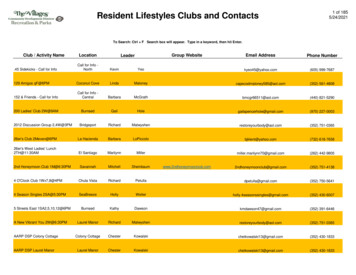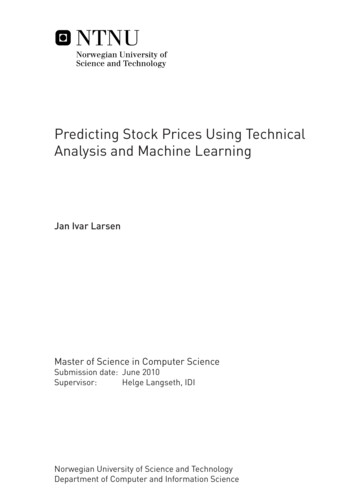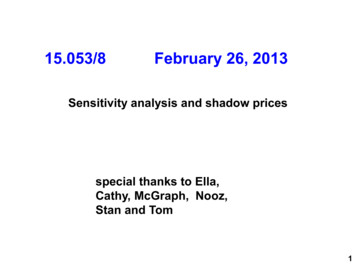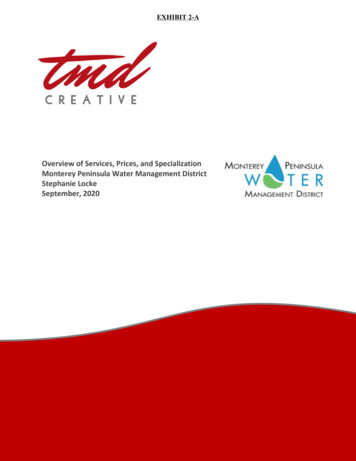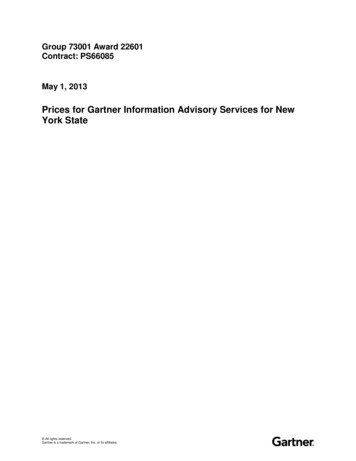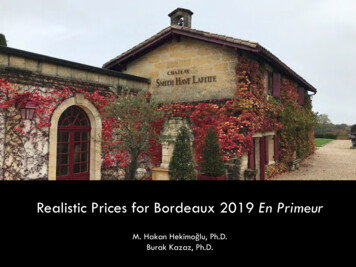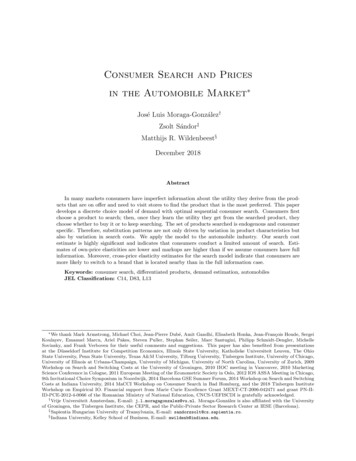
Transcription
Consumer Search and Pricesin the Automobile Market José Luis Moraga-González†Zsolt Sándor‡Matthijs R. Wildenbeest§December 2018AbstractIn many markets consumers have imperfect information about the utility they derive from the products that are on offer and need to visit stores to find the product that is the most preferred. This paperdevelops a discrete choice model of demand with optimal sequential consumer search. Consumers firstchoose a product to search; then, once they learn the utility they get from the searched product, theychoose whether to buy it or to keep searching. The set of products searched is endogenous and consumerspecific. Therefore, substitution patterns are not only driven by variation in product characteristics butalso by variation in search costs. We apply the model to the automobile industry. Our search costestimate is highly significant and indicates that consumers conduct a limited amount of search. Estimates of own-price elasticities are lower and markups are higher than if we assume consumers have fullinformation. Moreover, cross-price elasticity estimates for the search model indicate that consumers aremore likely to switch to a brand that is located nearby than in the full information case.Keywords: consumer search, differentiated products, demand estimation, automobilesJEL Classification: C14, D83, L13 We thank Mark Armstrong, Michael Choi, Jean-Pierre Dubé, Amit Gandhi, Elisabeth Honka, Jean-François Houde, SergeiKoulayev, Emanuel Marcu, Ariel Pakes, Steven Puller, Stephan Seiler, Marc Santugini, Philipp Schmidt-Dengler, MichelleSovinsky, and Frank Verboven for their useful comments and suggestions. This paper has also benefited from presentationsat the Düsseldorf Institute for Competition Economics, Illinois State University, Katholieke Universiteit Leuven, The OhioState University, Penn State University, Texas A&M University, Tilburg University, Tinbergen Institute, University of Chicago,University of Illinois at Urbana-Champaign, University of Michigan, University of North Carolina, University of Zurich, 2009Workshop on Search and Switching Costs at the University of Groningen, 2010 IIOC meeting in Vancouver, 2010 MarketingScience Conference in Cologne, 2011 European Meeting of the Econometric Society in Oslo, 2012 IOS ASSA Meeting in Chicago,9th Invitational Choice Symposium in Noordwijk, 2014 Barcelona GSE Summer Forum, 2014 Workshop on Search and SwitchingCosts at Indiana University, 2014 MaCCI Workshop on Consumer Search in Bad Homburg, and the 2018 Tinbergen InstituteWorkshop on Empirical IO. Financial support from Marie Curie Excellence Grant MEXT-CT-2006-042471 and grant PN-IIID-PCE-2012-4-0066 of the Romanian Ministry of National Education, CNCS-UEFISCDI is gratefully acknowledged.† Vrije Universiteit Amsterdam, E-mail: j.l.moragagonzalez@vu.nl. Moraga-González is also affiliated with the Universityof Groningen, the Tinbergen Institute, the CEPR, and the Public-Private Sector Research Center at IESE (Barcelona).‡ Sapientia Hungarian University of Transylvania, E-mail: sandorzsolt@cs.sapientia.ro.§ Indiana University, Kelley School of Business, E-mail: mwildenb@indiana.edu.
1IntroductionIn many markets, such as those for automobiles, electronics, computers, and clothing, consumers typicallyhave to visit stores to find out which product they like most. Though basic information about products sold inthese markets is usually easy to obtain either from television, the Internet, newspapers, specialized magazines,or just from neighbors, family, and friends, consumers search because some relevant product characteristicsare difficult to quantify, print, or advertise. In practice, since visiting stores involves significant search costs,most consumers engage in a limited amount of search.1Earlier work on the estimation of demand models (Berry, Levinsohn, and Pakes, 1995, 2004; Nevo, 2001;Petrin, 2002) has proceeded by assuming that consumers have perfect information about all the productsavailable in the market. In the market settings referred to above, the full information assumption is, arguably,unrealistic. In a study of the US computer industry, Sovinsky Goeree (2008) shows that departing fromthe perfect information assumption is important for obtaining realistic estimates of demand and supplyparameters. In her model, firms distribute advertisements about the existence and characteristics of thecomputers they sell. Advertisements are perfectly informative and consumers differ in the likelihood withwhich they are exposed to them. As a result consumers end up having heterogeneous and limited informationabout the existing alternatives in the market. Yet, in the setting of Sovinsky Goeree (2008) consumers donot need to incur any search costs to evaluate the utility they derive from the alternatives they happen tobe informed of via the advertisements.This paper adds to the literature on the structural estimation of demand models by presenting a discretechoice model of demand with optimal sequential consumer search. To the best of our knowledge our paperis the first to do this in a Berry, Levinsohn, and Pakes (1995) (BLP hereafter) framework. The distinctivefeature of the BLP framework is that a product’s utility depends on a structural error term, which is knownas an unobserved product characteristic in this literature, and is crucial for modeling price endogeneity. Thekey difference between our demand model and that in BLP is that in our model consumers do not know allthe relevant information about the products available and have to search in order to evaluate them. Searchis costly and consumers search sequentially through the available options. The costs of searching vary acrossindividuals and firms so consumers choose to visit distinct sellers even if they have similar preferences. Inour model consumer product information is thus endogenous and consumer specific. As a result, substitutionpatterns across products are not only driven by product differentiation but also by the variation in consumerinformation sets generated by costly search. Similar to the effects of advertising in Sovinsky Goeree (2008),search frictions thus generate heterogeneous and limited consumer information.We apply the model to the automobile market. The automobile market is precisely a market in whichadvertisements, reports in specialized magazines, television programs, and the Internet convey much but not1 Several recent empirical papers have found that consumers search relatively little. For instance, Honka (2014) reportsthat consumers obtain an average of 2.96 quotes when shopping for car insurance. De los Santos, Hortaçsu, and Wildenbeest(2012) find that over 75 percent of consumers visited only one online bookstore before buying a book online, whereas De losSantos, Hortaçsu, and Wildenbeest (2017) find that the mean number of online retailers searched is less than 3 for MP3 players.Some other examples of markets in which search frictions are found to be non-trivial are S&P 500 index funds (Hortaçsu andSyverson, 2004), automobiles (Moorthy, Ratchford, and Talukdar, 1997; Scott Morton, Silva-Risso, and Zettelmeyer, 2011), andthe retail market for illicit drugs (Galenianos and Gavazza, 2017).2
all the relevant information about the models available. As a result, a great deal of new car buyers visitdealerships to view, inspect, and test-drive cars. Given prior information about the products available atthe various sellers (such as size, horsepower, fuel efficiency, price, and design of a car), as well as the costs ofsearch (which we relate to dealership locations and certain consumer demographics), each consumer choosesthe order in which she will visit the sellers and, after each visit, whether to stop searching and buy one ofthe alternatives inspected so far or else to continue searching at the next seller. Following Weitzman (1979),the solution of this search problem consists of ranking the sellers in terms of reservation utilities, visitingthem in descending reservation utility order, and stopping search when the highest observed utility is abovethe reservation utility of the next option to be searched.The complexity of the real-world setting to which we apply our model—specifically, many alternativesavailable in the market that differ in ex-ante observable characteristics and search costs—makes the computation of the consumers’ buying probabilities a challenge. When there is a large number of alternativesavailable in the market, there are many ways through which a consumer may end up buying a particularproduct. For example, with just three alternatives, there are eleven distinct search paths a consumer mayfollow before deciding to buy a given product. As the number of alternatives increases, the number of searchpaths grows factorially, which makes Weitzman’s solution difficult to implement directly in settings in whichmany alternatives are available. To address this challenge, we adapt recent findings from the theoreticalsearch literature by Armstrong (2017) and Choi, Dai, and Kim (2018) that make it possible to compute thebuying probability of a given alternative without having to go explicitly through the myriad of possible waysin which a consumer may end up considering the alternative in question.We develop our search model in Section 2. Following Armstrong (2017) and Choi, Dai, and Kim (2018),we express a consumer’s search and purchase decision as a discrete choice problem in which a consumerchooses the alternative that offers the highest minimum of the reservation value and realized utility amongall available alternatives. We show how to use these probabilities to estimate the model, but, because theseexpressions are generally not closed form, estimation of the model is relatively slow. To speed up the process,we develop a method that significantly reduces the computational complexity of the model. We solve themodel backwards: starting from a distribution for the minimum of the reservation value and realized utilitythat leads to closed-form expressions for the buying probabilities, we derive a parametric specification forthe search cost distribution that rationalizes this distributional assumption. This alternative procedure isextremely practical and turns out to deliver estimates of demand, elasticities of demand, and markups thatare very similar to those obtained for alternative search costs distributions in the more general procedure.We discuss the estimation procedure as well as identification in Section 3. For the case in which searchcosts only depend on variables that are excluded from the utility function, search costs can be identifiedusing aggregate data only, and the model can be estimated using a similar approach as in BLP. In themore general case in which similar covariates enter both the utility and search cost function, we show inthe identification discussion in Section 3 that these common shifters can be separately identified by usingsearch data in addition. Intuitively, the combined effect—as opposed to the separate effects—of utility and3
search cost variables on purchases can be identified based on purchase decisions only. According to economictheory, the reservation values that guide search decisions respond differently to changes in utility shiftersthan to changes in search cost shifters, and, as a result, variation in observed search decisions allows usto separate the combined effect into a utility part and a search part. For example, a high market sharefor the outside option could be driven by a high utility for the outside option relative to the inside goods,or relatively high search cost. Without observing search decisions we cannot distinguish between the two.However, if according to search data consumers are searching a lot but end up not buying, it must be thatsearch costs are low and the utility for the outside option is high.We estimate our model’s main specification using aggregate data on characteristics and market shares,as well as individual-level survey data that contains information on purchases and related search behavior.Following Berry, Levinsohn, and Pakes’s (2004) two-step procedure, we use the aggregate data to obtain meanutilities, which capture the linear part of utility. These mean utilities and the individual-level survey dataare used to estimate the nonlinear parameters of the model, which include random coefficients as well as theparameters of the search cost specification. The moments that we use to estimate the nonlinear parametersare defined as the difference between a variety of predicted and observed (from the survey) purchase andsearch probabilities. As we discuss in more detail in the identification section, the exact moments weuse for estimation are picked such that there is a clear relation between them and the specific nonlinearvariable. In a second step we use the estimated mean utilities to estimate the linear utility parameters,using an instrumental variables approach to deal with price endogeneity. An advantage of using the two-stepprocedure in order to obtain estimates of search costs and other nonlinear parameters is that we do not needto impose restrictions on the joint distribution of unobserved heterogeneity and observed utility and searchcost shifters, making estimation of our model less susceptible to misspecification bias.In Section 4 we apply our model to the Dutch market for new cars and present our estimation results.Survey data reveal two important facts. First, consumers visit a limited number of car dealers before buyinga car—on average two for new car purchases—and the number of visits varies substantially across consumers.Second, a great deal of the dealer visits involve test-driving cars.2 We interpret these two facts as beingconsistent with our search model. We also provide some reduced-form evidence that search behavior isrelated to demographics such as income, family size, age, and distances to dealerships.Section 4 also discusses the estimation results for our main model. Our search cost estimates are highlysignificant and suggest consumers’ search costs are affected by distances to dealership and other demographicssuch as income, age, and household composition. Moreover, taking into account search costs leads to lesselastic demand estimates and higher estimates of price-cost margins compared to the standard BLP setting.According to our estimates, substitution patterns are not only driven by car characteristics but also bysearch costs, and our cross-price elasticity estimates indicate that consumers are relatively more likely toswitch to a brand that is located nearby than is the case in the full information model. We conclude thataccounting for costly search and its effects on generating heterogeneity in consumer choice sets is important2 According to survey data discussed in Section 4, respondents that were looking to buy a new car made a test drive in 45percent of dealer visits, and 75 percent made at least one test drive at one of the visited dealerships.4
for explaining variability in purchase patterns.In Section 4 we also use the estimates to perform several counterfactual analyses. Specifically, taking ourestimates as a starting point, we perform simulations that allow us to study the effects of lowering the costsof visiting dealerships on prices and profits. By offering home-delivered test drives, these traveling costs canbe brought down to near zero.3 Our simulation results indicate that average prices decrease by one percentwhen distance-related search costs go down to zero, with price decreases exceeding three percent for somecars. We find that the further away a dealer is (on average) from consumers, the less its price will be affectedby changes in distance-related search costs. This could be explained by the fact that buyers of brands thathave very few dealers tend to have relatively strong preferences for those brands.We also simulate the competitive effects of changes in the way manufacturers use their dealer networks.When a manufacturer incorporates a new brand to the group of brands it sells, it has the choice whetherto reorganize business and start retailing the new brand together with the existing ones. This is typically along run decision because such reorganizations involve the re-design and refurbishing of showrooms, whichmay involve large sunk costs. Our estimates of the gains from such business reorganizations provide lowerbounds for these sunk costs. We find that mergers of existing dealership networks could have nontrivialeffects on sales, prices, and profits.Related literatureOur paper builds on the theoretical and empirical literature on consumer search. At least since the seminalarticle of Stigler (1961) on the economics of information a great deal of theoretical and empirical work hasrevolved around the idea that the existence of search costs has nontrivial effects on market equilibria. Partof the effort has gone into the study of the effects of costly search in homogeneous product markets (seefor instance Burdett and Judd, 1983; Reinganum, 1979; Stahl, 1989). In this literature a fundamental issuehas been the existence of price dispersion in market equilibrium. Another tradition has been the study ofcostly search in markets with product differentiation. In a seminal contribution, Wolinsky (1986) notes thatsearch costs generate market power even in settings with free entry of firms. More recent contributionsinvestigate how product diversity (Anderson and Renault, 1999), product quality (Wolinsky, 2005), andproduct design (Bar-Isaac, Caruana, and Cuñat, 2012) are affected by costly search. As in our model,in this literature consumers search for a good product fit, and not for lower prices. Our search model ismost closely related to the framework of Wolinsky (1986) but we allow for asymmetric multi-product firms,consumer heterogeneity in both preferences and search costs, and, like in Choi, Dai, and Kim (2018) andHaan, Moraga-González, and Petrikaitė (2018), for price deviations to be observable before searching.Some recent empirical research on consumer search behavior has focused on developing techniques toestimate search costs using aggregate market data. Hong and Shum (2006) develop a structural method toretrieve information on search costs for homogeneous products using only price data. Moraga-González andWildenbeest (2008) extend the approach of Hong and Shum (2006) to the case of oligopoly and present a3 Inthe US, Seattle-based startup Tred allows consumers to test-drive and buy cars without having to visit the dealership.5
maximum likelihood estimator. Hortaçsu and Syverson (2004) study a search model where search frictionscoexist with vertical product differentiation. Our paper contributes to this line of work by incorporatingconsumer search into the BLP framework.A number of recent papers present related models of search and employ micro- or aggregate-level dataon search behavior to estimate preferences as well as the costs of searching. Although several of these papersalso focus on search for a good product fit (Kim, Albuquerque, and Bronnenberg, 2010; Kim, Albuquerque,and Bronnenberg, 2017), most of these papers assume that consumers are searching for prices (De los Santos,Hortaçsu, and Wildenbeest, 2012; Seiler, 2013; Honka, 2014; Koulayev, 2014; Pires, 2016; Honka, Hortaçsu,and Vitorino, 2017; Dinerstein, Einav, Levin, and Sundaresan, 2018). An important difference between thesepapers and ours is that they do not model unobserved product characteristics and hence they do not allowfor price endogeneity.4A further distinction can be made according to whether consumers are assumed to search sequentiallyor non-sequentially. A computational advantage of non-sequential search (De los Santos, Hortaçsu, andWildenbeest, 2012; Honka, 2014; Moraga-González, Sándor, and Wildenbeest, 2015; Murry and Zhou, 2018)is that consumers’ search decisio
that consumers obtain an average of 2.96 quotes when shopping for car insurance. De los Santos, Horta csu, and Wildenbeest (2012) nd that over 75 percent of consumers visited only one onl
